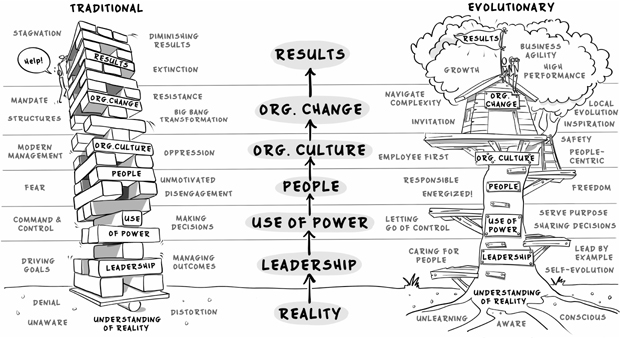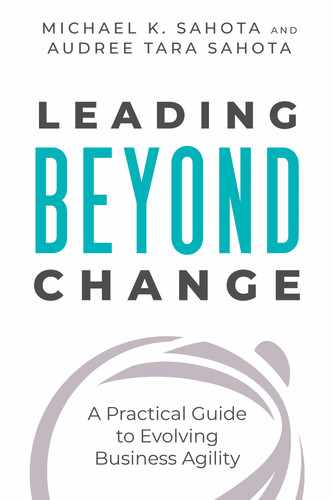16 ∎ CHANGE
Evolving Your Organization
For want of a nail, the shoe was lost.
For want of a shoe, the horse was lost.
For want of a horse, the rider was lost.
For want of a rider, the battle was lost.
For want of a battle, the kingdom was lost,
And all for the want of a horseshoe nail.
—Anonymous
Beyond Change
We hope that at this point any notion of linear, ordered, systematic change has completely left your system. The understanding that change is really about emergence is happening simultaneously on many levels and aspects of organizational systems.
Evolutionary leaders embrace the complexity and surrender to the emergence of what is coming. No one is in control. We are all co-creating the future together. It’s a messy, organic, nonlinear, unfolding with ups and downs, twists and turns. All we can do is expect the unexpected.
A growth in consciousness is required to lead and fully participate in such a journey. Leaders need to have enough inner psychological safety to stay the course and let go of control. It is important to understand the paradox of power to such a degree that they can uplift the safety of others while still creating a space for them to grow and contribute (we call this mastery).
History shows us that only a handful of leaders worldwide have been able to lead organizational evolution to such a degree that they have been able to create evolutionary organizations. The truth is that all the powerful tools for the evolution of organizations shared in this book will only unlock for you to the extent that you progress on your leadership journey.
SELF Core Principles
This book presents a rich tapestry of integrated insights important for navigating the inner and outer journey of evolution. The SELF Core Principles are the key principles that summarize the whole book.
The core principles can serve as a kata or practice to guide your own journey as you apply this work. We invite you to slowly read each core principle two times and pause to reflect what it feels like in your being.
Question Your Assumptions
The biggest trap for change is that leaders will interpret all the maps, models, tools, and principles in this book from their current level of consciousness. What this means is that one’s existing way of perceiving reality limits the ability to fully understand the meaning of what is shared here. While we may assume we understand, it’s more likely to be a partial or distorted understanding to fit with existing worldviews.
Our best advice is to assume that you don’t fully understand any part of this book so that you stay open to discovering deeper meanings. The astute reader will realize we are simply reminding you of a key to getting started with Evolutionary Leadership:
1. Create an engaging workplace: psychological safety is the cornerstone of high performance.
2. Unlearning is the most powerful form of learning: the ego is the root cause of performance issues.
3. Discover reality to unlock success: listen to the voice of the system.
4. Culture follows leadership: the consciousness of the leader is the limit of an organization.
5. All resistance is created by you: ability to navigate complexity depends on consciousness.
6. Organizational evolution follows leadership evolution: production capability = your future.
7. Put the oxygen mask on first: your own evolution is the most direct and rapid means to create high performance.
8. Employees first: believe in people.
9. Go with the energy: focus on local evolution.
10. Structures follow consciousness: a new way of being enables a new way of working.
Learn. Turn all your “ facts” and “knowledge” about understanding organizational change into assumptions to test and validate.
Of course, there are likely some very practical changes you can make with your current level of evolution. However, the full benefits and ability to unlock evolutionary change will only come as you grow and evolve yourself.
Let the Maps Guide You
At the start of a journey, it’s a good idea to study maps to see what route to take. Take the time to familiarize yourself with each dimension or level in the Traditional and Evolutionary maps. If you haven’t already done so, this is a good time to connect each of the patterns to the levels in the map. Take note of what parts of the maps are more comfortable for you and what parts are less clear.
Put the Oxygen Mask on First
The Reality Matrix Map (figure 16.1) shows the connection between cause and effect. So of course the best starting place is with you. Your understanding of reality. Your leadership. You can be the lynchpin— the horseshoe nail—that can save the kingdom. Any hope of evolution rests with your evolution. So your work is to put the oxygen mask on first. The level of evolution of your leadership will determine the upper bound for you to help anyone else.
Go with the Energy
Remember, the most important advice is to go with the energy. Who are the early adopters? Where can local change take place? What dimension or level of the Jenga/tree is more open to invitation at this time? What do people want?

Figure 16.1: Maps: Traditional to Evolutionary with Reality Matrix
How Long Will It Take?
Following a specific time frame is a guaranteed way to destroy any hope of real change. The rate of evolution of an organization is a reflection of the rate of evolution of the people in it.
Once one has made the choice to be an Evolutionary Leader, the emergence of an evolutionary organization around you is a matter of simple physics: progress is a function of your rate of evolution and time. As time is a fixed variable, the only factor that you have control over is your rate of evolution. This is why increasing your evolutionary capability—your rate of evolution—is the most important thing to focus on.
Model: Organizational Change: Traditional to Evolutionary

In table 16.1 we offer a contrast between Traditional and Evolutionary views of organizational change. The table is useful in highlighting challenges with an existing approach to organizational change and points to the possibility of evolving new approaches. Simply copying an Evolutionary approach to change is not going to work. That actually falls into the Traditional approach to “Solution Location.” Instead, what is needed is to find an approach to change that works in your unique context. Again, we reiterate that a shift in consciousness of the people leading the change is essential to escape this seeming paradox.
Table 16.1: Organizational Change: From Traditional to Evolutionary
| Belief/Topic | Traditional | Evolutionary |
| Goal | Define the target state that can be achieved. | Create a “star on the horizon”—an ideal to be strived toward. |
| Complexity | The workings of the organization can be modeled and understood. | The organization is a very complex system—we can only have a limited understanding. |
| Organizational nature | The organization is a mechanical system. | The organization is a complex system. |
| Model of change | The organization can be mechanically changed from one way of functioning to another. | It’s an emergent journey, not a destination. |
| Time frame | It is possible to plan and achieve a shift in organizational functioning in a fixed time horizon. | The future will emerge over time. |
| Solution location | It is possible and practical to copy solutions from other organizations. | Our organization applies internal and external information to find solutions that work in our context. |
| Control | The change process can be controlled. | The change process is emergent, and we see how to influence it. |
| Approach | Transformation program. | Everyday work. |
| Choice | Change is mandatory. | Change is invited—people grow at a rate they can handle. |
| Leadership | Role is delegate responsibility and to support change. | Role is to assume responsibility and to model and inspire change. |
| Scope | Everyone needs to change. | Sustainable change happens locally. |
| Motivation | Focus is on mandating change and ignoring or squashing resistance. | Invitation and inspiring change. Creating space and time to integrate people and groups. |
| Culture awareness | Strategy and tactics dominate agenda. | Culture is considered the foundation of all change. |
Your Turn
• Where on the spectrum from Traditional to Evolutionary is the approach to organizational change where you work?
• What assumptions do you have about what effective organizational change should look like in your environment?
• What is your personal rate of evolution?

